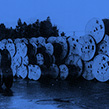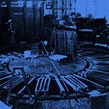Continuous copper casting and rolling machine, Fuji Factory (2014)
Episodes in Yazaki’s development and business growth
This section presents episodes describing Yazaki product development,
through which our predecessors brought wire harnesses and many other flagship products to the world.
HOME Episodes in Yazaki’s development and business growth The egg lays the chicken: The secret story behind the birth of the wire harness

Wire harnesses
The egg lays the chicken:
The secret story behind the birth of the wire harness

An encounter with wire harnesses
Which came first, the chicken or the egg? Asking this question will spark an endless debate, but, really, which one was it?
Or how about this question: Which came first, Yazaki or the wire harness? Yazaki created the wire harness, so obviously it is Yazaki, right?
The correct answer is: the wire harness came first. The Yazaki Group was born in 1941 as Yazaki Densen Kogyo K.K. However, the Group’s founder, Sadami Yazaki, began selling wire harnesses as a one-man business twelve years earlier in 1929, when he was still a young man of just 21 years.
It was at the end of May 1924, the year after the Great Kanto Earthquake, that a highly ambitious Sadami Yazaki arrived in Tokyo from his home in Nagano. He was only sixteen years old. Coming from a poor family and not having the opportunity to go beyond an elementary school education, Sadami started his career as an apprentice at Trading Company “M,” which operated a clothing and general goods wholesale store in the Nihombashi Yokoyama-cho district. There, his inherent cheerfulness and hard work quickly made him a standout. Around that time, he began working in electric wire sales that Trading Company “M” started as a new business. He found the work of “purchasing copper, fabricating it to the contractor’s specifications, applying rubber coating and braid to make a finished product, and then selling it” to be fun.
Japan’s only wire harness specialist
Sadami began wondering if there were any untapped wire customers out there. Then one day, as he was walking through the town looking for potential sales avenues for electric wires, something still quite unusual in those days suddenly caught his eye: an automobile. “Wait a minute,” he thought. “I wonder what kind of wiring cars have.” He immediately went to a car repair shop that routinely handled automotive products to find out. Of course, the car the shop showed him was foreign. The car’s wires were much thinner than the ones he was used to seeing. Several were grouped together and fastened in a slack fashion rather than stretched taut. “I see,” he said. “It looks like they form a harness.” At that moment he had a sudden inspiration. “Cars are still rare in Japan. I would venture to say that there are no wire harness specialists to be found here. That’s it! I’ve found my work!”
Sadami began studying wire harnesses that very day. Though busy with his regular duties, he found time to visit car repair shops that were his company’s clients and electric wire factories in order to gain knowledge. He even learned the English term “wire harness.” In time, his employment at Trading Company “M” came to an end, and he decided to become independent by launching a business that specialized in wire harness sales. That moment in 1929 was when the egg (wire harnesses) gave birth to the chicken (Yazaki).
Gaining prosperity together with the domestic automobile industry
Although Sadami was now independent, all of the cars on Japan’s roads at the time were American-made Japan Ford and Japan GM vehicles. At the beginning, he mainly sold wire harnesses for these brands that were brought into repair shops. He purchased copper with his scarce capital, had an electrical wire factory fabricate wires at the specified thicknesses for him, and then fashioned them into wire harness samples to gain sales. It was truly a shoestring operation. However, at a time when shortages existed, domestically produced wire harnesses were welcomed and his business gradually started moving in the right direction. In June 1932, a domestic car company was launched as a joint venture by three companies: Ishikawajima, Tokyo Gas Electric Engineering and DAT. In December of the same year, Manshu Jidosha, a military supply company, was established. Sadami continually endeavored to expand sales to such up-and-coming car companies by advertising himself as “Japan’s only wire harness specialist.”
In 1938, Sadami established Yazaki Densen Eigyo-bu as a joint stock company. In 1939, he set up the new company’s Oku Factory in Kita Ward, Tokyo, and began manufacturing ordinary electrical wires as well as wire harnesses. And in 1941 he established Yazaki Densen Kogyo K.K. As events would have it, 1941 was also the year that war erupted between Japan and the United States.
EPISODE SELECTION
EPISODE 01 Aroace: Overcoming obstacles buoyed on the founder’s adventurous spirit
EPISODE 02 The egg lays the chicken: The secret story behind the birth of the wire harness
EPISODE 03 A drum business that conserves valuable wood resources and recycles waste plastic
EPISODE 04 “LP10”: The gas meter that changed how people think about propane
EPISODE 05 Moving toward a sustainable future as a pioneer in the use of solar heat
EPISODE 07 From the quagmire of labor dispute rose the grand flower of the meter
EPISODE SELECTION















